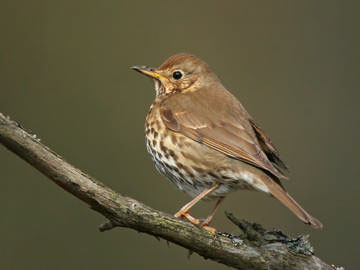
Song Thrush © Steve Round
Song Thrushes were recorded in winter in 621 tetrads, 18 fewer than in the breeding season. The map shows that there were a few odd tetrads in which they were not found, but the only places they are truly absent are the estuarine saltmarshes and the eastern hills. This is not a very hardy species, withdrawing from most of the uplands of northern Britain (BTO Winter Atlas) and it seems that there is some altitudinal migration even within Cheshire. They were not found in 13 of the highest tetrads, ten of which were occupied in the breeding season. At the other end of the county, two or three Song Thrushes were counted on Hilbre – where they did not breed – during each winter of this survey.
The movement from the hill country is interesting because it seems that the migratory status of British Song Thrushes is probably changing, as has happened with Blackbirds. Earlier analyses showed that most birds wintered away from their natal area, but nowadays it is suggested that the typical winter behaviour of Song Thrushes should be described as ‘residency, interrupted sometimes by cold-weather movements’ (Migration Atlas). There is more migration from northern Britain than from the south, however, and continued study of the county’s birds is warranted, including observations of the dates of return to their eastern breeding sites, and the effect of winter weather on this susceptible species.
In addition to the British-bred Song Thrushes, there is some autumn passage of Fennoscandian birds, mostly moving through on their way to Iberia, but a few stay in Britain for the winter, as do many birds from the Netherlands and Belgium (Migration Atlas). These birds are of different races and occasionally ‘funny-looking’ Song Thrushes – slightly larger and greyer above with whiter underparts – are seen wintering in Cheshire and Wirral. A bird caught at Norton Priory, Runcorn on 12 January 1986 had been ringed on the Norfolk coast on 18 October 1985, and was likely to have been a migrant from Fennoscandia, although not all birds from the east coast are immigrants as another bird caught at the same site on 20 November 1988 was certainly British-bred, having been ringed in North Yorkshire on 18 June that year as a chick in the nest.
In winter, Song Thrushes have a mixed diet of soil invertebrates, especially worms and snails, and fruit from bushes such as rowan, hawthorn, ivy and holly. Several observers noted that they seem to like horse paddocks, where the close-cropped grass allows easy access to earthworms. The only substantial difference in habitat from the breeding season to winter is that the proportion in farmland hedgerows doubled from 11% of records to 22%, mostly at the expense of records from woodland, with little change in other farmland codes and human sites. Even so, out of our five wintering thrushes, this is the one most likely to be found in woodland and least likely to frequent farmland, based on the percentages of submitted habitat codes. Song Thrushes tend not to form large flocks, and more than half of the counts submitted were of single birds. There were only five reported gatherings of ten or more, including about twelve that David Bowman counted feeding in 200 metres of hedgerow near Rixton (SJ68Z) on 19 December 2006, and a large roost found by Steve Binney and Frank Gleeson in winter 2004/ 05 near Brimstage (SJ38B).
A further indication of the sedentary nature of most of our Song Thrushes is that many birds sing from November onwards, some continuing throughout the winter period, and almost all breeding territories are established by mid-February (Snow 2003), thus merging the two seasons of this Atlas.
Sponsored by Henry Finch

